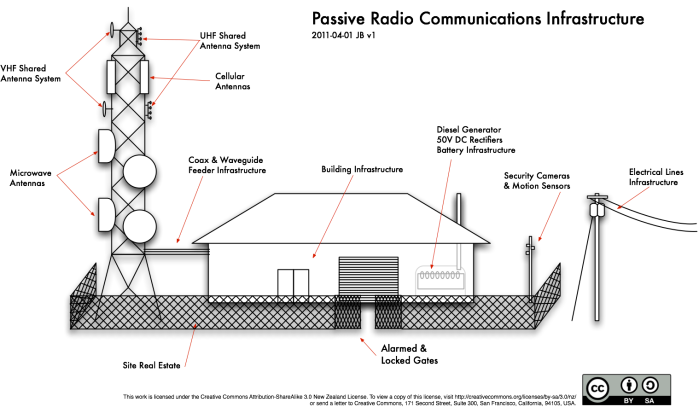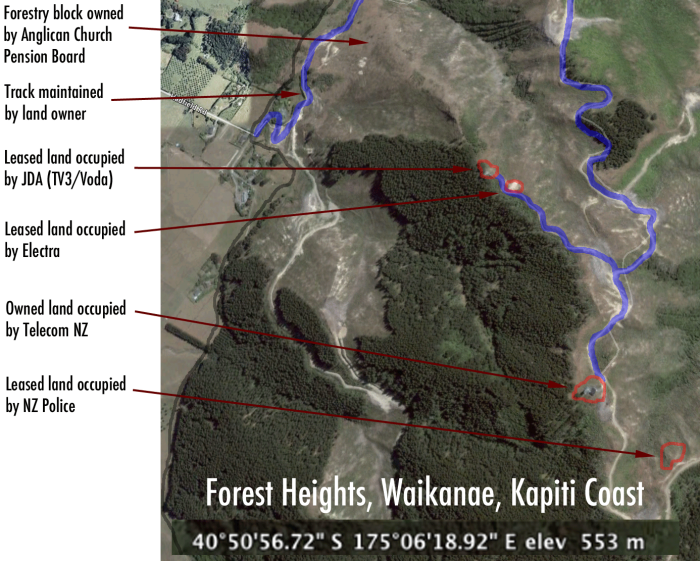“Mobile infrastructure sharing is an alternative for lowering the cost of network deployment, especially in rural and less populated or marginalized areas.” (Lefevre, 2008) Infrastructure sharing can be as basic as sharing a hilltop or as complicated as sharing active network equipment. In this post, the various options available for passive infrastructure sharing will be discussed, with a focus on rural towers.
Passive Infrastructure refers to that infrastructure not directly involved in actively transmitting information. In addition to physical objects, elements such as electricity, cooling technology, and non-cellular transmission are considered passive, because management of these elements does not have an impact on the coverage or capacity of the mobile network.
The most basic form of passive infrastructure sharing involves separate sites sharing only the land and access road to the land. The diagram below shows a map of a single block of land with four separate radio communications sites located on it. With the exception of the Telecom NZ site, all are leased from the overall land owner. The Telecom NZ site has its own title, from the days of the Post Office when the government acquired the land.
Site maintenance required for land to remain useful for telecommunications is part of the passive infrastructure of the site. In a rural New Zealand site, land use will either be grazed, planted with exotic forest, or in exceptional cases covered with native bush and/or tussock. Native bush surrounding tower sites must be carefully maintained. Should exotic forest be planted directly adjacent to a property, an expensive tower may become useless for many requirements. In the case above, forestry planted by the land owner obstructs the Telecom NZ tower from direct line of sight communications in to Waikanae.
The importance of safe site access for regular maintenance cannot be underemphasized. Rural towers are frequently located on high sites with kilometers of track between them and the nearest road. Many high sites in New Zealand are frequently inaccessible by helicopter due to weather or lack of suitable landing areas. Should a track become impassible via ute, a fault could lead to a tower being offline for days or weeks. In some cases, rural tracks leading to tower sites were originally built by the government of New Zealand, and due to location or soil type require minimal annual maintenance. In the case of the diagram above, the private dirt track needs regular maintenance. Run-off resulting from forest harvesting and ruts resulting from the heavy forestry vehicles that use the track mean that bulldozers must frequently smooth the track. Telecommunications users on this block of land are charged an annual access fee by the land owner that pays for the upkeep of the track while returning a profit to the land owner.
Electricity lines infrastructure, including poles and transformers, is another passive infrastructure asset that can be shared by operators on the same hill but occupying separate land areas and towers. In the case of a new site establishment, a telecommunications provider will pay the local lines company to install overhead lines and a transformer. When a second provider builds a tower on the same hill, the lines company will ask the two parties to work together on costs. The incumbent provider will typically assess the competitor a portion of the original lines infrastructure build cost, often with an administration fee tacked on.
Site Sharing goes further than just access track sharing, and it typically what is meant when Mobile Co-Location is discussed. The diagram below is based on one produced by India’s Telecom Regulatory Authority (TRAI, 2007), but adapted to include the infrastructure common on large rural telecommunications sites in New Zealand:

Radio and cellular tower sites in New Zealand have many elements described above, but may be more or less suitable for site sharing depending on what the site was originally established for, and when. In the majority of cases, it’s older sites that are the most suitable for site sharing.
Broadcast and telecommunications towers established from the 1960s through to the 1980s were typically built to house multiple services and large, heavy infrastructure. Buildings beside them were constructed from concrete or block, and included drive-in garages for technicians. Many included kitchens and toilets, and emergency overnight accommodation facilities. Over the years, as technological change has obsoleted or dramatically shrunk this older infrastructure, these sites have become free to host new and different infrastructure through site sharing arrangements.
With corporatization and privatization of broadcast and telecommunications respectively, coupled with the Resource Management Act of 1991, tower construction took on a new form. From the mid-1990s through to the present day, purpose-built small towers and small portable buildings became the standard. These building and tower designs, capable of housing a single operator and its equipment, were marginally less expensive than larger facilities. Their small visual footprints were easy to push through the bureaucracy of local councils newly empowered by the RMA. And their small size came with the competitive bonus of blocking third parties from the ability to use the facilities through site sharing.
On those older sites, the sharing of infrastructure is relatively straightforward. Given a motivated site owner, many passive infrastructure items can be shared between parties. Using the example of Chorus and a 1980s Microwave Tower as diagrammed above, I’ll examine the various shared passive infrastructure elements not yet discussed.
Real estate space is typically enclosed by a tall chain-link fence topped with barbed wire. This is as much to provide safety to potential visitors as it is to prevent theft or vandalism. Some older generations of telecommunications equipment can emit dangerous levels of radiation. Access gates are locked and alarmed, so that the site owner will know if the gate is open. In sensitive sites, or those easily accessible by road, the fenced-in yards are sometimes covered by motion sensors and video cameras. Alarms are monitored by a central organization who keep track of technicians on-site and the critical environmental and security states of each building. In the case of Chorus towers, the central organization is Telecom Security.
Rural telecommunications building infrastructure often includes huts with multiple locked rooms. This allows users such as the Police and Transpower to keep their sensitive equipment out of the way of telecommunications technicians. The buildings traditionally have rainwater collection and storage to provide water for toilets and sinks. Many older generation buildings have basic kitchen facilities and bunk rooms, in case technicians become stuck at a remote site due to weather conditions or an extended fault. Building maintenance of such infrastructure is typically outsourced to a company like Transfield Services.
Electricity is the most common reason for a rural New Zealand site to go down. Rural hilltop sites are subject to extreme environmental conditions, and the electrical lines infrastructure in some areas is knocked out on a regular basis. For that reason, large rural sites always have diesel generators and battery banks to smooth transitions between mains and diesel. They also have rectifier systems to convert the mains supplied 230 volt alternating current to the 50V direct current required by telecommunications equipment. The maintenance of such systems involves running the engines at least an hour a week, regularly checking and refilling the diesel tanks, and conditioning the battery banks by alternatively draining and restoring them at least every six months.
Feeder systems are cables that link equipment from inside of a building to the tower. Traditionally these systems were made of rigid waveguide or coaxial cables – very heavy, copper based cables that carry wireless communications from transmitters and receivers located inside the building up to antennas on the tower. Longer distances and higher frequencies require thicker cables to prevent loss of signal along the path. These cables often add more weight and wind/ice loading to a tower than the largest of antennas. Sharing of these cables while antennas are shared is a common practice. Sharing of feeders with separate antennas is less common, but achievable through the use of duplexers and filters at the feeder ends. New generation cellular and microwave communications equipment locates transmitter and receiver equipment on the mast near to the antennas to prevent signal losses in the feeders. It is common now to feed this equipment with fibre optic cables and DC power, leading to far smaller, lighter cables on the tower, freeing tower capacity for greater antenna and auxiliary equipment loads.
Antenna systems fall in three main categories. Omnidirectional VHF and UHF antennas radiate low frequency communications in all directions evenly. These systems are easy to share between operators, because they are typically optimized for maximal ground coverage and engineered not to use frequencies that could interfere with nearby towers. Dozens of operators could use the same VHF and UHF systems on a well engineered tower. Sectorial antennas (labelled cellular antennas in the diagram above) typically cover an area between 60-120 degrees from the base station, in a pattern that simplistically could be thought of as a pie shape. Low frequency sectorial antennas (up to 1GHz), have fixed coverage patterns and can often be shared in the manner of VHF and UHF antennas. Higher frequency sectorial antennas (2GHz+) can be fixed, in which case sharing between operators is viable, or can have variable coverage patterns depending on network loadings, in which case they are now active infrastructure and sharing between operators is not viable. Discussion of cellular antenna planning and sharing merits its own analysis. Microwave antennas are fixed devices that allow communications between one tower and another. Sharing microwave antennas between two providers is trivial, and between four providers can be done with appropriate planning and coordination. Much like a fibre optic cable, different waves can be multiplexed together to allow the providers to share a single path between two places.
Mobile infrastructure sharing, also known as Mobile Co-Location, is an established practice around the world. Its utility in lowering costs in rural telecommunications is undisputed. Technically, as shown above, it is not a complicated issue. The degree of mobile co-location in New Zealand however has been extremely limited to date, almost entirely due to commercial reasons discussed elsewhere on this site. Awareness of the issues behind Mobile Co-Location by legislators, regulators, telecommunications providers, and local governments is critical to the continued development of rural New Zealand, and should be taken into account in the funding of any new rural infrastructure by government initiatives.

Great post, very insightful.
Hopefully they don’t end up setting the barrier to entry for smaller operators too high, would be great to see more options and real competition.
LikeLike